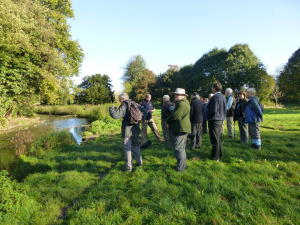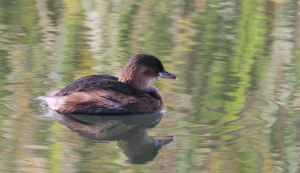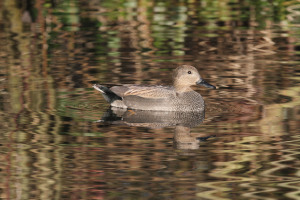This RSPB Bexley Group event was led by Ralph and Brenda Todd, who have provided this report and photos.
Not one but two kingfishers called and flew up river behind Michael Heath (Chair of Friends of Foots Cray Meadows and Co-ordinator for the Thames21 Cray River team) as he explained to the 21 attendees the recent works carried out along the river Cray north of Five Arches towards Bexley. These works are restoring this historic chalk river to enable it to flow better and create some vegetated margins and also to help protect the banks from further erosion. A group of long-tailed tits flew out from the overhead trees. A great start, we then led the group back towards Five Arches but birds were thin on the ground, in the air and in the trees with only crows, woodpigeons and the ubiquitous ring-necked parakeets showing themselves.
The weather was superb, clear blue skies, sun shining, not at all what should be expected end of October or when we are leading (often overcast or wet or is that just a myth?). Five Arches proved to be more active with the mute swan family, many mallard and black-headed gulls (mostly adult with just a few first year birds for identification comparison) feeding near the bridge. Further along the bank with the sun behind us made for wonderful light to enjoy the grey heron, cormorant, a pair of gadwall, moorhen, coots and at least 3 little grebe.
We continued along the culvert to Mitchells Field but still few birds: jays, the occasional robin, blackbird and goldfinch. A grey wagtail was spotted flying, given away by its distinctive call. Even the secluded area behind All Saints Church was quiet -though a nearby great spotted woodpecker proved elusive but was seen by most. We wandered back on the west side of the river enjoying the good weather and various pieces of information about the meadows – such a wonderful open space accessible to all.
We wondered where all the birds were? Autumn can be an unpredictable time of year, summer visitors have migrated south and given the recent mild conditions perhaps those birds from further north or the continent have not arrived and those migrating further south flying straight over on clear nights. Having said that, some 27 species were recorded on the walk, if not in the numbers we might have wanted but given the good company, lovely weather and an appreciation of how lucky we are to have such a wonderful site as Foots Cray Meadows to enjoy we left knowing that we’d return again, either individually or on another organised visit in the future.
List of Species seen: Little Grebe (min 3), Cormorant, Mute Swan (pr+3 juvs), Gadwall (6), Mallard, Tufted Duck (17), Grey Heron, Moorhen, Coot, Black-headed Gull, Stock Dove, Woodpigeon, Ring-necked Parakeet, Kingfisher (2), Great Spotted Woodpecker, Grey Wagtail, Wren, Robin, Blackbird, Long-tailed Tit, Blue Tit, Great Tit, Jay, Magpie, Jackdaw, Carrion Crow, Goldfinch.




Sounds like a wonderful day, shame I missed it. I have noticed recently that the kingfishers seem more numerous, or perhaps just more visible – I’ve seen four in the past 3 visits, most unexpected! I’ve also seen the wonderful cormorant – anyone know how long it has been at FCM, and if it is the only one?
One of the attendees commented on more sightings of kingfisher at this time of year – think it is a combination of young birds finding new sites and adults venturing further away from nesting territories. As for cormorants, only one yesterday but often 2 or 3, Danson Park can have similar numbers so think they are birds just moving around – obviously lots on/near the Thames.
Thanks for your reply, that does explain the apparent abundance of kingfishers.